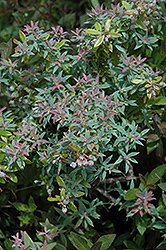It's all about ...
plants

Rosa's Blush Blueberry
Vaccinium darrowii 'Rosa's Blush'
Height: 4 feet
Spread: 4 feet
Sunlight:
![]()
![]()
Hardiness Zone: 8a
Other Names: Darrow's Blueberry
Group/Class: Brazzleberries Collection
Description:
This exciting, compact dwarf variety produces rose pink new foliage that matures to dusty blue-green in summer, then deep purple in winter; abundant crop of sweet blueberries in late spring; great for the garden or patio containers
Edible Qualities
Rosa's Blush Blueberry is a small shrub that is commonly grown for its edible qualities, although it does have ornamental merits as well. It produces clusters of blue round berries which are usually ready for picking in late spring. The berries have a sweet taste and a juicy texture.
The berries are most often used in the following ways:
- Fresh Eating
- Cooking
- Baking
- Preserves
Features & Attributes
Rosa's Blush Blueberry features dainty clusters of shell pink bell-shaped flowers hanging below the branches in early spring. It has red-variegated bluish-green foliage which emerges rose in spring. The glossy oval leaves turn an outstanding plum purple in the fall, which persists throughout the winter. It features an abundance of magnificent blue berries in late spring.
This is a multi-stemmed evergreen shrub with a mounded form. Its average texture blends into the landscape, but can be balanced by one or two finer or coarser trees or shrubs for an effective composition. This is a relatively low maintenance plant, and usually looks its best without pruning, although it will tolerate pruning. It is a good choice for attracting birds to your yard. It has no significant negative characteristics.
Aside from its primary use as an edible, Rosa's Blush Blueberry is sutiable for the following landscape applications;
- Accent
- General Garden Use
- Orchard/Edible Landscaping
- Container Planting
Planting & Growing
Rosa's Blush Blueberry will grow to be about 4 feet tall at maturity, with a spread of 4 feet. It tends to be a little leggy, with a typical clearance of 1 foot from the ground. It grows at a medium rate, and under ideal conditions can be expected to live for approximately 30 years. This variety requires a different selection of the same species growing nearby in order to set fruit.
This shrub is quite ornamental as well as edible, and is as much at home in a landscape or flower garden as it is in a designated edibles garden. It does best in full sun to partial shade. It does best in average to evenly moist conditions, but will not tolerate standing water. It is very fussy about its soil conditions and must have sandy, acidic soils to ensure success, and is subject to chlorosis (yellowing) of the foliage in alkaline soils. It is quite intolerant of urban pollution, therefore inner city or urban streetside plantings are best avoided, and will benefit from being planted in a relatively sheltered location. Consider applying a thick mulch around the root zone in winter to protect it in exposed locations or colder microclimates. This is a selection of a native North American species.
Rosa's Blush Blueberry is a good choice for the edible garden, but it is also well-suited for use in outdoor pots and containers. Because of its height, it is often used as a 'thriller' in the 'spiller-thriller-filler' container combination; plant it near the center of the pot, surrounded by smaller plants and those that spill over the edges. It is even sizeable enough that it can be grown alone in a suitable container. Note that when grown in a container, it may not perform exactly as indicated on the tag - this is to be expected. Also note that when growing plants in outdoor containers and baskets, they may require more frequent waterings than they would in the yard or garden. Be aware that in our climate, most plants cannot be expected to survive the winter if left in containers outdoors, and this plant is no exception. Contact our experts for more information on how to protect it over the winter months.
This plant is not reliably hardy in our region, and certain restrictions may apply; contact the store for more information.

